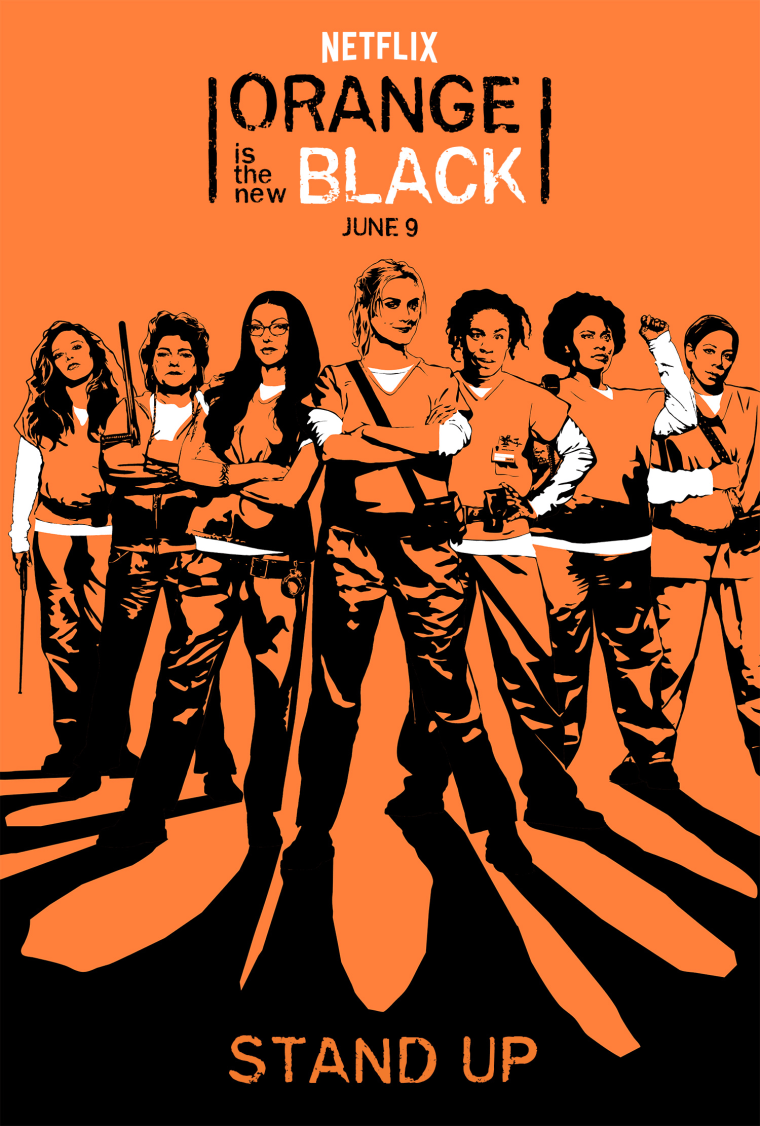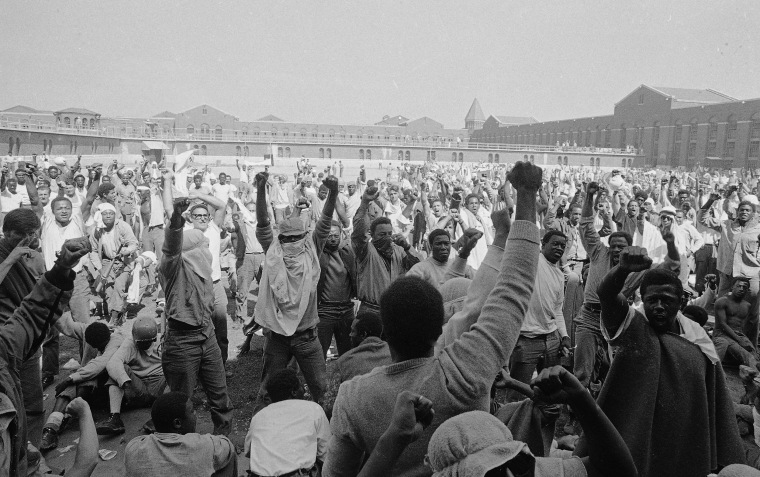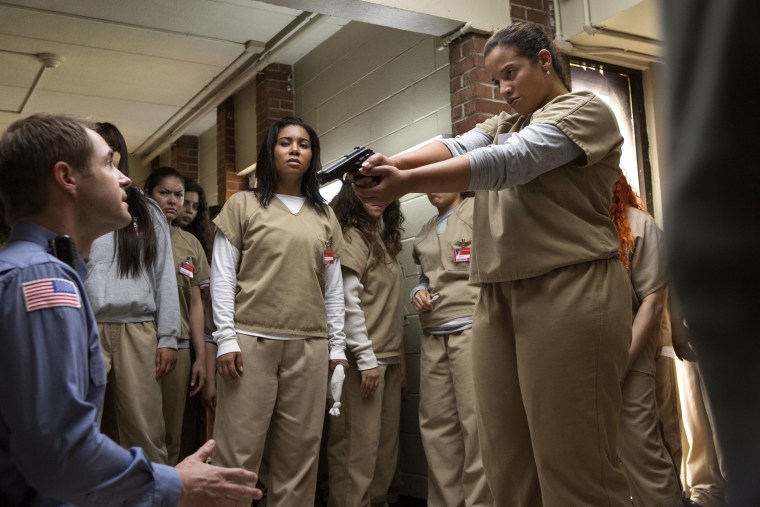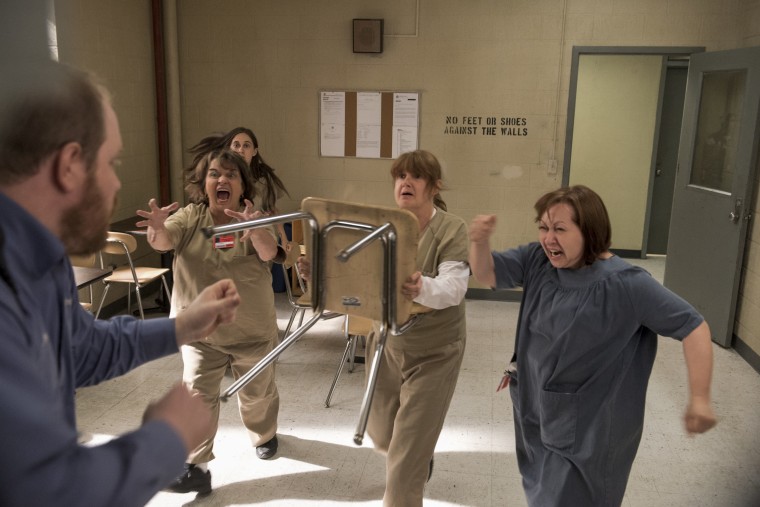"We get beat for no reason. We’re stuffed four in a bunk like we're factory chickens. We're denied basic humanity." —Tastee, "Orange is the New Black"
This Friday night don’t expect your partner to accompany you to dinner and a movie.
Likely they’ll be on the couch glued to the TV. For a full year they, along with many millions of other Americans, have been waiting on tenterhooks, for the new season of Netflix’s smash scripted series, Orange is the New Black.
To be sure this show has an unlikely set of protagonists--women prisoners locked up inside of the Litchfield Correctional Facility. But viewers everywhere have come to care very much what happens to them.
This is especially true as this season begins. In last season’s cliffhanger the women at Litchfield had just exploded in an all-out prison rebellion, and we were left not knowing at all how their dramatic standoff with state officials would end.
As it turns out, what happens on Orange is the New Black is worth watching carefully.
Yes, it is a fictionalized account of life in a made-up penal facility. But via this series Americans have finally gotten an intimate look at a space that they otherwise are barred from seeing—the inside of one of our nation’s more than 6,000 correctional facilities.
Inside of these awful places more than 2.3 million people are locked up -- women who very much resemble the loveable Poussey Washington, the complicated “Crazy Eyes,” the hapless Alison, the angry Tastee, and the overwhelmed Piper.
Indeed, thanks to the real Piper upon whose life this series is based, and thanks to series creators’ commitment draw upon the actual experiences of the incarcerated, Orange is the New Black has taught ordinary Americans some critically important things about this country’s criminal justice system that they otherwise might never have thought much about.
Related: ‘Orange Is the New Black’ author: From inmate to advocate
Viewers can see firsthand, for example, that there is far less connection than they might imagine between those who actually do harm and break laws, and those who end up behind bars.
They also see quite clearly that those who do end up locked up--disproportionately poor people, black and brown people, drug addicted people and people suffering mental illness--pay a far higher price than mere physical confinement. Too often they are also sexually assaulted and physically abused.
Perhaps most important, this series has allowed us all to recognize—some of us for the first time--that the people who end up in prison aren’t monsters. They are just like us. They have feelings, they have families, and for all of the problems they have, they also have abundant possibilities.
This is why viewers cared so much last season when the abuses suffered by the women in Litchfield mounted.

This is why we all understood when these women finally launched a peaceful protest in the cafeteria to call attention to their plight and to improve their conditions.
This is why we all cried when guards not only ended that protest with ugly violence, but also killed one of the women in the process.
This is why we, like the prisoners in Litchfield felt fury when we learned that the guard who killed that woman wouldn’t be charged.
And this is why we should all be quite a worried about what might happen to these women in season 5 now that they are in the midst of an all-out prison uprising--particularly because when these women began this rebellion at the end of season 4, they were chanting “Attica! Attica! Attica!”
Related: Editorial: Lessons From The Attica Prison Uprising, 45 Years Later
By invoking “Attica!” in its latest storyline of prison rebellion, the writers of Orange is the New Black are hinting that we might be in store for another disturbing lesson which is that the costs of resisting prison abuse can be staggering.
Many viewers might have not fully understood the reference to “Attica” in the last powerful episode of Orange is the New Black, other than, perhaps, having it vaguely resonate from the 1973 movie starring Al Pacino called Dog Day Afternoon.
Invoking Attica, however, is deeply meaningful as, undoubtedly, Litchfield prisoners such as Tastee (who works in the prison library), understood very well.
Back 1971 at the Attica State Correctional facility in upstate New York nearly 1300 men exploded in a dramatic and ultimately historic four-day uprising because they too finally got sick of overcrowding, ugly conditions, and guard abuse.

There are, so far, quite a few important similarities between the prison riot that began in Season 4 of Orange is the New Black and the real Attica uprising of 1971 for viewers to pay attention to.
In both Attica and Litchfield prisoners first tried to get basic improvements to the terrible conditions they endured by engaging in a peaceful protest.
In both Attica and Litchfield correction officers severely overreacted to the these prisoners calls for better conditions.
In both Attica and Litchfield the prisoners then exploded, in anguish and anger, in an all-out rebellion, taking over the institution and taking hostages so that they might now make state officials listen to them.
And the season 5 trailer hints at even more similarities.
In both Attica and Litchfield correction officers severely overreacted to the these prisoners calls for better conditions.
In both uprisings the prisoners also understood that the world was watching and that it was important to bring the media in to hear why they were protesting and to make sure that officials would bargain with them in good faith.
In both uprisings prisoners who have long been divided understood that they had to, as Maria put it, “stand united as one,” if they were to have any hope of getting what they needed.

And in both uprisings passionate speeches were made about the need for the public to recognize the fundamental humanity of the incarcerated. Echoing the words of Attica prisoner L.D. Barkley back in 1971, Alison looks into the camera in the season 5 trailer and emphatically states, "We the inmates at Litchfield are human beings. We are protesting the abusive conditions of which we are being held.”
But this is where, we hope, the similarities end.
After those four long days and nights of peaceful negotiation with state officials at Attica, on the fifth morning and without warning, and after incapacitating the men inside with CS gas, hundreds of heavily armed troopers stormed the prison.
Within 15 minutes of firing many thousands of bullets and shotgun pellets at men with no guns and no place to run, the death and injury toll were horrific. 39 men, prisoners and hostages alike lay dead and a total of 128 men were so badly wounded that it would take years for them to recover fully, if they ever did.
Related: White House Summit Focuses on Women in Prison
And then the prisoners were tortured. Unimaginably abused for days, weeks, months. Perhaps worse, for the next four decades when these men tried to tell the public what had happened, and to hold guards and troopers accountable, state officials repeatedly tried to discredit them and to make the public doubt their account.
It remains to be seen what lessons we will learn from the uprising of women at the Litchfield Correctional facility also, it seems, located in upstate New York. The hints we have so far, however, are worrisome.
Let’s not forget that the whole protest began at the end of season 4 because the women at Litchfield weren’t seen as human beings by the guards. Who can forget the guard screaming at his fellow officers to “get that f----in’ animal outta here!” when they were responding to the first peaceful protest in the cafeteria.

And, of course, when a guard actually kills one of these women, her life doesn’t even merit that guard losing his job. As Tastee exclaimed in anguish after Bayley kills Poussey, “They ain’t even gonna fire him…they called him the f---ing victim…they didn’t even say her name!”
Notably, as well, prison management in this show also worked hard to make sure the public would never believe the prisoners’ accounts of this killing. As warden Joey Caputo put it in a press briefing season 4, “any allegations from them are just not credible.”
Finally, and most alarmingly, though, we were left at end of season 4 with a gun, a gun smuggled in by a CO. As Attica reminds us, that does not bode well at all.
Let’s hope that the women at Litchfield aren’t gunned down and tortured for daring to stand up for their fundamental humanity.
So on Friday night, and for the next 13 weeks, we will all be watching closely to see how this prison rebellion unfolds and, more importantly, how it ends.
Let’s hope that the women at Litchfield aren’t gunned down and tortured for daring to stand up for their fundamental humanity.
But if they are, let’s hope that watching it happen to them will remind us of all that the Attica prisoners endured back in 1971 and how really heartbreaking it was, and remains, that prison officials turned the public against them and against prisoners more generally for the next 45 years.
If nothing else, Season 5 of Orange is the New Black is our chance finally to appreciate what terrible things finally push human beings into fighting back, what lengths state officials will go to in order to discredit them, and how important it is nevertheless to listen to what they are telling us is going on.
Heather Ann Thompson is a historian at the University of Michigan and the Pulitzer Prize Winning author of "Blood in the Water: The Attica Prison Uprising of 1971 and its Legacy"
